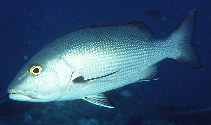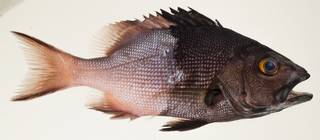WoRMS taxon details
Lutjanus bohar (Forsskål, 1775)
218479 (urn:lsid:marinespecies.org:taxname:218479)
accepted
Species
Diacope labuan Montrouzier, 1857 · unaccepted (synonym)
Diacope quadriguttata Cuvier, 1828 · unaccepted (synonym)
Lutianus bobar (Forsskål, 1775) · unaccepted (misspelling)
Lutianus bohar (Forsskål, 1775) · unaccepted
Lutianus nukuhivae Seale, 1906 · unaccepted (synonym)
Lutjanus coatesi Whitley, 1934 · unaccepted (synonym)
Lutjanus rangus (Cuvier, 1828) · unaccepted
Mesoprion rangus Cuvier, 1828 · unaccepted (synonym)
Mesoprion rubens MacLeay, 1882 · unaccepted (synonym)
Sciaena bohar Forsskål, 1775 · unaccepted (synonym)
Sparus cynodon Bloch, 1791 · unaccepted
Sparus lepisurus Lacepède, 1802 · unaccepted (synonym)
marine, brackish, fresh, terrestrial
(of Sciaena bohar Forsskål, 1775) Niebuhr, C. (1775). Descriptiones animalium avium, amphibiorum, piscium, insectorum, vermium; quae in itinere orientali observavit Petrus Forskål. <em>Post mortem auctoris edidit Carsten Niebuhr. Hauniae.</em> 1-20 + i-xxxiv + 1-164, map. [Pisces on pp. x-xix and 22-76]., available online at http://www.biodiversitylibrary.org/item/18564
page(s): 46, xi [details]
page(s): 46, xi [details]
Description Inhabits coral reefs, including sheltered lagoons and outer reefs. Usually found solitarily, often adjacent to steep outer...
Description Inhabits coral reefs, including sheltered lagoons and outer reefs. Usually found solitarily, often adjacent to steep outer reef slopes. Feeds mainly on fishes, but also takes shrimps, crabs, amphipods, stomatopods, gastropods and urochordates. Large fish from oceanic areas in the western Pacific are often ciguatoxic, e.g. in Tuvalu (Ref. 9513). Utilized fresh and dried-salted (Re. 9987). Reported to grow up 90 cm in length (Ref. 9987). The young have been repported to mimic certain damselfishes of the genus Chromis, such as C. ternatensis (Bleeker) and thereby get closer to their prey <307>. [details]
Froese, R. and D. Pauly. Editors. (2024). FishBase. Lutjanus bohar (Forsskål, 1775). Accessed through: World Register of Marine Species at: https://www.marinespecies.org/aphia.php?p=taxdetails&id=218479 on 2024-04-16
Date
action
by
![]() The webpage text is licensed under a Creative Commons Attribution-Noncommercial 4.0 License
The webpage text is licensed under a Creative Commons Attribution-Noncommercial 4.0 License
original description
(of Sciaena bohar Forsskål, 1775) Niebuhr, C. (1775). Descriptiones animalium avium, amphibiorum, piscium, insectorum, vermium; quae in itinere orientali observavit Petrus Forskål. <em>Post mortem auctoris edidit Carsten Niebuhr. Hauniae.</em> 1-20 + i-xxxiv + 1-164, map. [Pisces on pp. x-xix and 22-76]., available online at http://www.biodiversitylibrary.org/item/18564
page(s): 46, xi [details]
original description (of Sparus lepisurus Lacepède, 1802) Lacepède, B.G.E. (1802). Histoire naturelle des poissons: IV. <em>chez Plassan: Paris, France.</em> v. 4: i-xliv + 1-728, Pl. 1-16., available online at https://www.biodiversitylibrary.org/page/6705733
page(s): 45, 141 [details]
original description (of Mesoprion rangus Cuvier, 1828) Cuvier, G.; Valenciennes, A. (1828). Histoire naturelle des poissons. Tome second. Livre Troisième. Des poissons de la famille des perches, ou des percoïdes. 2: i-xxi + 2 pp + 1-490, Pls. 9-40.
page(s): 481 [details]
original description (of Diacope quadriguttata Cuvier, 1828) Cuvier, G.; Valenciennes, A. (1828). Histoire naturelle des poissons. Tome second. Livre Troisième. Des poissons de la famille des perches, ou des percoïdes. 2: i-xxi + 2 pp + 1-490, Pls. 9-40.
page(s): 427 [details]
original description (of Sparus cynodon Bloch, 1791) Bloch, M. E. (1782-95). Allgemeine Naturgeschichte der Fische. 12 volumes. [details]
context source (Deepsea) Intergovernmental Oceanographic Commission (IOC) of UNESCO. The Ocean Biogeographic Information System (OBIS), available online at http://www.iobis.org/ [details]
context source (HKRMS) Hong Kong marine fish database. <em>AFCD.</em> , available online at https://www.hk-fish.net/en/fish/introduction/ [details]
basis of record Froese, R. & D. Pauly (Editors). (2023). FishBase. World Wide Web electronic publication. version (02/2023)., available online at https://www.fishbase.org [details]
additional source Liu, J.Y. [Ruiyu] (ed.). (2008). Checklist of marine biota of China seas. <em>China Science Press.</em> 1267 pp. (look up in IMIS) [details] Available for editors [request]
[request]
ecology source Looby, A.; Erbe, C.; Bravo, S.; Cox, K.; Davies, H. L.; Di Iorio, L.; Jézéquel, Y.; Juanes, F.; Martin, C. W.; Mooney, T. A.; Radford, C.; Reynolds, L. K.; Rice, A. N.; Riera, A.; Rountree, R.; Spriel, B.; Stanley, J.; Vela, S.; Parsons, M. J. G. (2023). Global inventory of species categorized by known underwater sonifery. <em>Scientific Data.</em> 10(1). (look up in IMIS), available online at https://doi.org/10.1038/s41597-023-02745-4 [details]
page(s): 46, xi [details]
original description (of Sparus lepisurus Lacepède, 1802) Lacepède, B.G.E. (1802). Histoire naturelle des poissons: IV. <em>chez Plassan: Paris, France.</em> v. 4: i-xliv + 1-728, Pl. 1-16., available online at https://www.biodiversitylibrary.org/page/6705733
page(s): 45, 141 [details]
original description (of Mesoprion rangus Cuvier, 1828) Cuvier, G.; Valenciennes, A. (1828). Histoire naturelle des poissons. Tome second. Livre Troisième. Des poissons de la famille des perches, ou des percoïdes. 2: i-xxi + 2 pp + 1-490, Pls. 9-40.
page(s): 481 [details]
original description (of Diacope quadriguttata Cuvier, 1828) Cuvier, G.; Valenciennes, A. (1828). Histoire naturelle des poissons. Tome second. Livre Troisième. Des poissons de la famille des perches, ou des percoïdes. 2: i-xxi + 2 pp + 1-490, Pls. 9-40.
page(s): 427 [details]
original description (of Sparus cynodon Bloch, 1791) Bloch, M. E. (1782-95). Allgemeine Naturgeschichte der Fische. 12 volumes. [details]
context source (Deepsea) Intergovernmental Oceanographic Commission (IOC) of UNESCO. The Ocean Biogeographic Information System (OBIS), available online at http://www.iobis.org/ [details]
context source (HKRMS) Hong Kong marine fish database. <em>AFCD.</em> , available online at https://www.hk-fish.net/en/fish/introduction/ [details]
basis of record Froese, R. & D. Pauly (Editors). (2023). FishBase. World Wide Web electronic publication. version (02/2023)., available online at https://www.fishbase.org [details]
additional source Liu, J.Y. [Ruiyu] (ed.). (2008). Checklist of marine biota of China seas. <em>China Science Press.</em> 1267 pp. (look up in IMIS) [details] Available for editors
ecology source Looby, A.; Erbe, C.; Bravo, S.; Cox, K.; Davies, H. L.; Di Iorio, L.; Jézéquel, Y.; Juanes, F.; Martin, C. W.; Mooney, T. A.; Radford, C.; Reynolds, L. K.; Rice, A. N.; Riera, A.; Rountree, R.; Spriel, B.; Stanley, J.; Vela, S.; Parsons, M. J. G. (2023). Global inventory of species categorized by known underwater sonifery. <em>Scientific Data.</em> 10(1). (look up in IMIS), available online at https://doi.org/10.1038/s41597-023-02745-4 [details]
 Present
Present  Present in aphia/obis/gbif/idigbio
Present in aphia/obis/gbif/idigbio  Inaccurate
Inaccurate  Introduced: alien
Introduced: alien  Containing type locality
Containing type locality
From other sources
Description Inhabits coral reefs, including sheltered lagoons and outer reefs. Usually found solitarily, often adjacent to steep outer reef slopes. Feeds mainly on fishes, but also takes shrimps, crabs, amphipods, stomatopods, gastropods and urochordates. Large fish from oceanic areas in the western Pacific are often ciguatoxic, e.g. in Tuvalu (Ref. 9513). Utilized fresh and dried-salted (Re. 9987). Reported to grow up 90 cm in length (Ref. 9987). The young have been repported to mimic certain damselfishes of the genus Chromis, such as C. ternatensis (Bleeker) and thereby get closer to their prey <307>. [details]
To Barcode of Life (49 barcodes)
To Biodiversity Heritage Library (13 publications) (from synonym Sciaena bohar Forsskål, 1775)
To Biodiversity Heritage Library (15 publications) (from synonym Sparus lepisurus Lacepède, 1802)
To Biodiversity Heritage Library (18 publications) (from synonym Diacope quadriguttata Cuvier, 1828)
To Biodiversity Heritage Library (18 publications) (from synonym Mesoprion rangus Cuvier, 1828)
To Biodiversity Heritage Library (19 publications) (from synonym Lutianus bohar (Forsskål, 1775))
To Biodiversity Heritage Library (2 publications) (from synonym Lutianus nukuhivae Seale, 1906)
To Biodiversity Heritage Library (38 publications)
To Biodiversity Heritage Library (4 publications) (from synonym Mesoprion rubens MacLeay, 1882)
To Biodiversity Heritage Library (5 publications) (from synonym Lutjanus coatesi Whitley, 1934)
To Biodiversity Heritage Library (5 publications) (from synonym Lutjanus rangus (Cuvier, 1828))
To Biological Information System for Marine Life (BISMaL)
To Biological Information System for Marine Life (BISMaL) (from synonym Sciaena bohar Forsskål, 1775)
To European Nucleotide Archive (ENA)
To FishBase
To FishBase (from synonym Lutjanus coatesi Whitley, 1934)
To FishBase (from synonym Sciaena bohar Forsskål, 1775)
To FishBase (from synonym Sparus lepisurus Lacepède, 1802)
To FishBase (from synonym Lutianus bohar (Forsskål, 1775))
To FishBase (from synonym Lutjanus rangus (Cuvier, 1828))
To FishBase (from synonym Diacope labuan Montrouzier, 1857)
To FishBase (from synonym Diacope quadriguttata Cuvier, 1828)
To FishBase (from synonym Lutianus nukuhivae Seale, 1906)
To FishBase (from synonym Lutianus bobar (Forsskål, 1775))
To FishBase (from synonym Mesoprion rubens MacLeay, 1882)
To FishBase (from synonym Mesoprion rangus Cuvier, 1828)
To FishBase images (Lutjanus bohar, Indonesia, by Randall, J.E.)
To GenBank (79 nucleotides; 32 proteins) (from synonym Sciaena bohar Forsskål, 1775)
To GenBank (79 nucleotides; 32 proteins)
To Global Biotic Interactions (GloBI)
To IUCN Red List (Least Concern)
To NMNH Extant Collection (Lutjanus bohar USNM 403231 photograph lateral view)
To NMNH Extant Collection (Lutjanus bohar USNM 439896 photograph lateral view)
To ITIS
To Biodiversity Heritage Library (13 publications) (from synonym Sciaena bohar Forsskål, 1775)
To Biodiversity Heritage Library (15 publications) (from synonym Sparus lepisurus Lacepède, 1802)
To Biodiversity Heritage Library (18 publications) (from synonym Diacope quadriguttata Cuvier, 1828)
To Biodiversity Heritage Library (18 publications) (from synonym Mesoprion rangus Cuvier, 1828)
To Biodiversity Heritage Library (19 publications) (from synonym Lutianus bohar (Forsskål, 1775))
To Biodiversity Heritage Library (2 publications) (from synonym Lutianus nukuhivae Seale, 1906)
To Biodiversity Heritage Library (38 publications)
To Biodiversity Heritage Library (4 publications) (from synonym Mesoprion rubens MacLeay, 1882)
To Biodiversity Heritage Library (5 publications) (from synonym Lutjanus coatesi Whitley, 1934)
To Biodiversity Heritage Library (5 publications) (from synonym Lutjanus rangus (Cuvier, 1828))
To Biological Information System for Marine Life (BISMaL)
To Biological Information System for Marine Life (BISMaL) (from synonym Sciaena bohar Forsskål, 1775)
To European Nucleotide Archive (ENA)
To FishBase
To FishBase (from synonym Lutjanus coatesi Whitley, 1934)
To FishBase (from synonym Sciaena bohar Forsskål, 1775)
To FishBase (from synonym Sparus lepisurus Lacepède, 1802)
To FishBase (from synonym Lutianus bohar (Forsskål, 1775))
To FishBase (from synonym Lutjanus rangus (Cuvier, 1828))
To FishBase (from synonym Diacope labuan Montrouzier, 1857)
To FishBase (from synonym Diacope quadriguttata Cuvier, 1828)
To FishBase (from synonym Lutianus nukuhivae Seale, 1906)
To FishBase (from synonym Lutianus bobar (Forsskål, 1775))
To FishBase (from synonym Mesoprion rubens MacLeay, 1882)
To FishBase (from synonym Mesoprion rangus Cuvier, 1828)
To FishBase images (Lutjanus bohar, Indonesia, by Randall, J.E.)
To GenBank (79 nucleotides; 32 proteins) (from synonym Sciaena bohar Forsskål, 1775)
To GenBank (79 nucleotides; 32 proteins)
To Global Biotic Interactions (GloBI)
To IUCN Red List (Least Concern)
To NMNH Extant Collection (Lutjanus bohar USNM 403231 photograph lateral view)
To NMNH Extant Collection (Lutjanus bohar USNM 439896 photograph lateral view)
To ITIS


